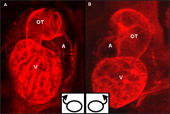Developmental genetics
Research carried out encompasses all aspects of genetics ranging from basic science to genetic service delivery. This is facilitated by close integration of the academic and clinical departments.
The main aim of the research undertaken is to understand the cellular and molecular processes behind both normal development and genetic disease and to improve diagnosis and management of human genetic disorders and birth defects.
Dysmorphology
The unit has an international reputation as a centre of expertise in Dysmorphology, the study of birth defects. Research in this area has included the study of rare genetic disorders associated with learning disability including William's syndrome, Angelman syndrome, Cohen syndrome and Costello syndrome. Clinical research studying the diagnosis and natural history of these conditions is complemented by molecular studies to explore the genomic architecture of the chromosomal regions involved and the study of animal models to examine gene expression and function.
Learning disability syndromes
Learning disability syndromes have been a major focus of research, with recent work concentrating on chromosomal rearrangements and imbalance and the use of array comparative genomic hybridisation in the investigation of learning disability. Environmental causes of learning disability are being explored in a long term prospective follow-up study of children born to mothers with epilepsy and a control cohort. This study, in addition to looking at malformation rates has examined in detail the long term medical and neuropsychological problems of the children concerned.
Dyscerne
Manchester is the lead partner for Dyscerne, an EU-funded initiative to develop an electronic web-based diagnostic system for rare dysmorphic syndromes. The department is also involved in the development of personal health records for rare genetic disorders and is currently piloting records for neurofibromatosis, achondroplasia and Di George syndrome. The department hosts the two-yearly Manchester Dysmorphology Conference. This international meeting, attended by 160 delegates is held at the University of Manchester Conference Centre.
For further information, see: Dyscerne website
Principal investigators
| Name | Job title | Email address |
|---|---|---|
| Dian Donnai | Professor of Medical Genetics | dian.donnai@cmft.nhs.uk |
| May Tassabehji | Reader | m.tassabehji@manchester.ac.uk |
| Jill Clayton-Smith | Consultant and Honorary Professor in Clinical Genetics | jill.clayton-smith@cmft.nhs.uk |
| Bronwyn Kerr | Consultant and Honorary Senior Lecturer in Clinical Genetics | Bronwyn.kerr@cmft.nhs.uk |
| Siddharth Banka | Senior Lecturer in Genetic Medicine | siddharth.banka@manchester.ac.uk |
Growth
The genetic contribution to normal growth is being explored through the study of short stature syndromes. Autozygosity mapping is being used to identify genes involved in autosomal recessive short stature syndromes and the gene for 3M syndrome was recently identified. This work is undertaken in collaboration with the Endocrinology and Diabetes Group.
Other well defined patient cohorts currently under investigation include Kabuki syndrome and Coffin Siris Syndrome, where both candidate gene and comparative genomic hybridisation are being employed.
Principal investigators
| Name | Job title | Email address |
|---|---|---|
| Graeme Black | Professor of Genetics and Ophthalmology | graeme.black@manchester.ac.uk |
| Bronwyn Kerr | Consultant in Clinical Genetics | Bronwyn.kerr@cmft.nhs.uk |
| Peter Clayton | Professor of Child Health and Paediatric Endocrinology | peter.clayton@manchester.ac.uk |
Clefting
Manchester has a strong history of research into clefting disorders. Current research areas include integrated genetic and biochemical approaches to identify molecular pathways driving cranio-facial development in Treacher Collins syndrome and Van der Woude syndrome.
The use of the Affymetrix SNP platform to analyse DNA from patients with syndromic clefts has proven useful in the identification of candidate loci involved in oro-facial clefting. Strong clinical links with the North West/North Wales cleft centre which sees 120 new cleft patients per year have led to several collaborative projects looking at genetic and environmental interactions in clefting and have contributed to multi-centre management trials by facilitating clinical diagnosis and patient selection for cleft trials.

